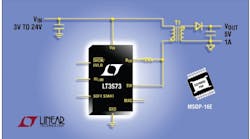Linear Technology's LT3573 is an isolated monolithic flyback switching regulator with an integrated 1.25-A, 60-V npn power switch. The LT3573 significantly simplifies the design of a flyback converter by eliminating the need for a third transformer winding or an optoisolator. To do so, it senses the output voltage directly from the primary-side flyback waveform.
Operating over an input-voltage range of 3 V to 40 V, the LT3573 delivers up to 7 W of output power with no external power devices required. The company notes that applications in the 2-W to 5-W range stand to benefit the most from this regulator. The output voltage is set using two external resistors. The regulator can be used in a wide variety of industrial, medical, datacom and automotive applications requiring isolated power, including marine electronics, power-over-Ethernet and VoIP telephone interfaces.
The LT3573 operates in boundary mode (also known as critical conduction mode). This variable-frequency current-mode switching scheme achieves a total regulation band of ±3% over a wide input-voltage range and output load current in a typical application. Boundary-mode operation also permits the use of a smaller transformer when compared to equivalent continuous-conduction mode designs. Moreover, boundary-mode operation produces less-conducted and radiated EMI than continuous-conduction mode. The maximum switching frequency is specified as 1 MHz typical.
Currently, there are several isolated flyback controllers or regulators that use primary-side sensing, and these do not require an optoisolator as would be needed with second-side sensing of the output. Nevertheless, these devices typically require a third primary-side winding, which they use to sense the output voltage. By eliminating that third winding, the LT3573 reduces the size and cost of the transformer. To further simplify the magnetics design, the company recommends several pre-designed transformers for popular input-/output-voltage combinations, but the LT3573 also works with many standard off-the-shelf transformers.
Although there is an existing isolated flyback regulator, Linear's LT1425, that like the LT3573 senses the isolated output voltage directly from the primary-side flyback waveform, this part differs from the newer part in a few important regards. For one, the LT3573 operates over a wider input-voltage range, which is a narrower 3.1 V to 20 V on the older device. Also, the newer device operates in boundary mode, while the LT1425 does not. The new part also features better reference voltage accuracy over temperature, a variable rather than fixed operating frequency, and features like adjustable current limit and programmable soft start that are not available on the older part. Device packaging is also smaller on the LT3573.
Naturally, there are challenges to overcome when sensing the output voltage from the primary side. For starters, information about the output voltage is only available when the flyback pulse is present, which requires precise timing of when the flyback error amplifier is enabled. Also, the flyback error amplifier must be able to handle a higher voltage than would be seen with secondary-side sensing, since the flyback pulse is greater than VIN.
In addition, the LT3573 senses the output voltage at its switch pin only when the secondary winding is conducting current. Because the sampling circuit requires a minimum time to sample this voltage, a minimum load current must be maintained in the application to ensure the regulator turns on/off enough to sample the output voltage. This minimum load is typically only 1% to 2% of full load.
Additional features of the LT3573 include undervoltage lockout and output-voltage temperature compensation. In addition, the chip incorporates an on-board LDO for applications with higher input voltages (>20 V) where a third winding may be used to bias the chip for better system efficiency.
The device operates over a junction temperature range of -40°C to 125°C. Available in a thermally enhanced, 16-lead MSOP and in a 3-mm 3 3-mm DFN, it is priced starting at $2.76 each in 1000-piece quantities.
